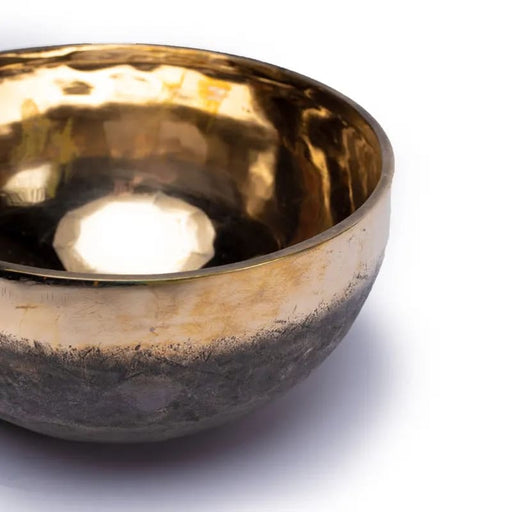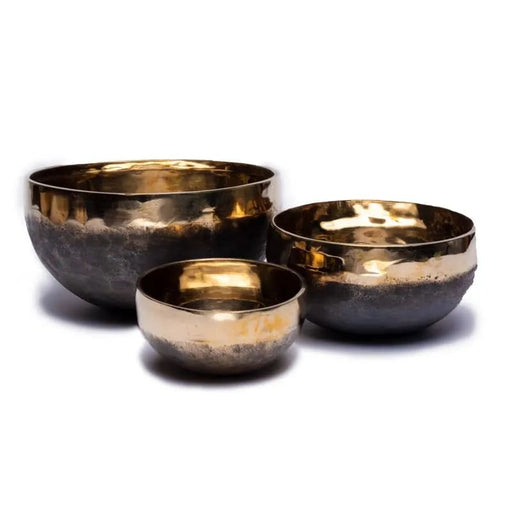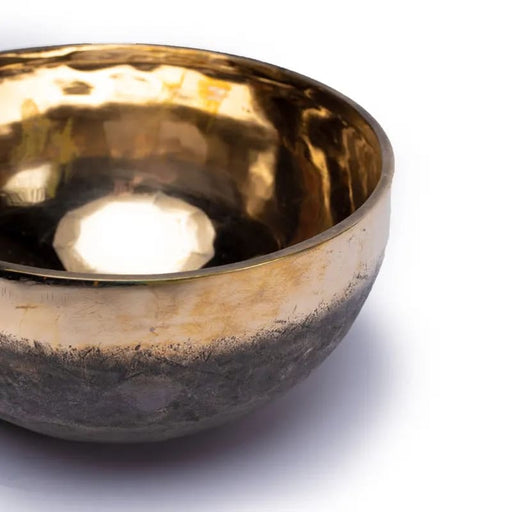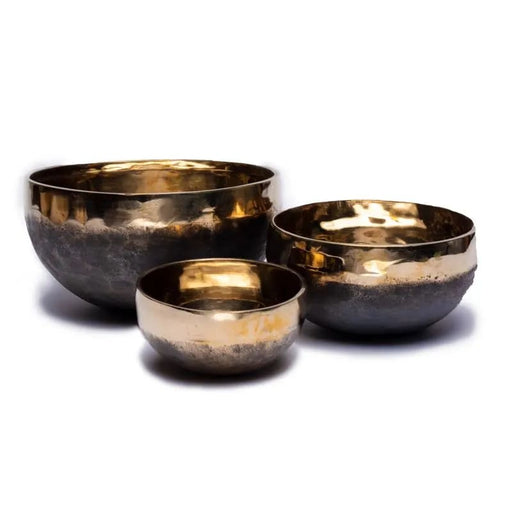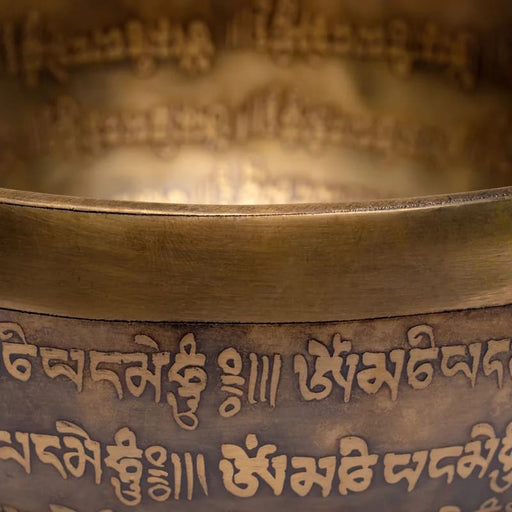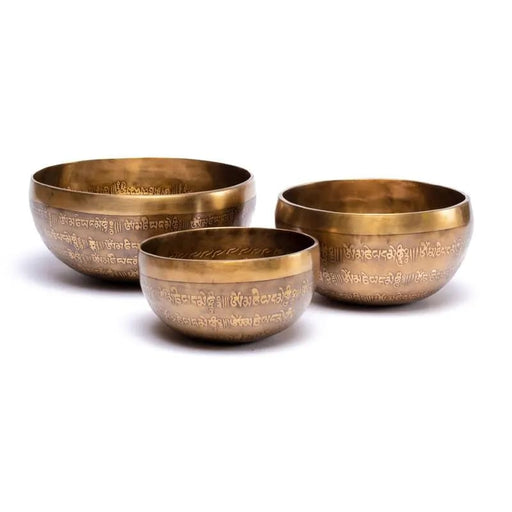
Silver plated Shakyamuni Buddha Sound Bowl ±1100-1200 ±21
Silver-plated, decorated sound bowl
A silver-plated, decorative sounding bowl with carved images of Buddha Shakyamuni and the five Dhyani Buddhas. The bowl is also decorated with auspicious symbols such as the double dorje, lotus and endless knot, as well as the compassion mantra 'Om Mani Pad Me Hum'. The silver plating is carried out by a careful electrolysis process, which covers each bowl with a shiny layer of pure silver, which enriches its sound and vibration.
Buy the drum stick separately
Art and craftsmanship
Each hand-forged sounding bowl is first carefully selected for its rich sound, so that it not only looks beautiful, but also has the depth and resonance expected of a sounding bowl of this quality. Only then is the bowl engraved and silver plated.
Traditional symbols and decorations are engraved with precise laser technology, which allows the addition of complex patterns without weakening the acoustic properties of the sound bowl.
The silver plating process is carried out by electroplating, which uses controlled electrolysis. In this case, the desired metal coating is transferred from the anode (the part that contains the metal to be used) to the cathode (the part that will be coated - in this case, the sound bowl). This ensures even coverage.
Advantages of silver plating
Silver, due to its high density and excellent acoustic properties, enhances the natural purity of the vocal cords, creating a clear and uplifting sound.
The bowl's reflective surface not only adds to its aesthetic appeal, but can also amplify the energy it emits, making it a powerful tool for meditation and sound healing.
Maintenance and storage
In order to preserve the beautiful surface and powerful sound of your silver-plated sound bowl, we recommend using only a soft mallet made of wool and a felt mallet. As an additional treatment, you can use cotton gloves to handle the bowl. Wipe the bowl carefully with a soft cotton cloth after each use to remove fingerprints and maintain the shine. Store the bowl with a stable rubber ring or soft pillow to protect its shape and surface.
Each silver-plated sound bowl comes with a cotton bag to protect and store it, and three pairs of cotton gloves (sizes M, L and XL).
For cleaning, use a damp, non-abrasive cloth and mild soap and water. Avoid harsh chemicals and abrasive cleaners to preserve the silver finish. However, a silver cloth can help.
Made with care in Nepal
Our sound bowl is skillfully made in Nepal by expert craftsmen who combine traditional techniques passed down from generation to generation with modern technology.
Different types of sound bowls produce different sounds and vibrations, which makes them suitable for different uses. Let's look at some common types of sound bowls and their uses:
1. Metal Sound Bowls (Tibetan Bowls):
- Manufacturing: Traditionally made from a mixture of different metals.
- Sound: Produce a complex, multi-layered sound that lasts a long time.
- Usage: Commonly used in meditation, relaxation and spiritual exercises.
- Suitability: An excellent all-purpose bowl for various purposes, including group meditations and personal use.
2. Crystal sound bowls:
- Manufacturing: Mostly made of purified quartz crystal.
- Sound: Clear and clean sound that resonates clearly.
- Use: Popular for chakra balancing, sound therapy and energy work.
- Suitability: Ideal for personal use and therapeutic purposes, especially when focusing on a specific chakra or energy field.
3. Body Bowls:
- Construction: Typically made of metal, designed to be worn directly on the body.
- Sound: Deep and rich in resonance, meant to be felt physically in the body.
- Use: Used for physical healing, relaxation and alleviation of physical ailments.
- Suitability: Great for promoting physical and emotional well-being, especially good for combining physical touch and sound.
4. Chakra Bowls:
- Fabrication: Can be both metallic and crystalline, often tinted or tuned to match specific chakras.
- Sound: Specific pitches that resonate with specific chakras.
- Use: For chakra balancing, meditation and spiritual work.
- Suitability: Perfect for those who focus on chakra work and energy harmony.
5. Handmade/Unique Sound Bowls:
- Manufacturing: Individually manufactured, often unique materials and designs.
- Sound: Unique sound profile that varies by manufacturer and materials.
- Use: Special purposes such as unique meditations or personal use.
- Suitability: Suitable for those who are looking for a unique sound experience or want a special cup for personal use.
6. Himalayan Bowls:
- Manufacturing: Traditional style, often hand-struck, made of metal alloy.
- Sound: Rich and multidimensional, lasts a long time.
- Use: Meditation, spiritual ceremonies, relaxation.
- Suitability: Suitable for traditional spiritual practices and group meditations.
When choosing a sound bowl, it is important to think about your personal needs and what you want to achieve by using the bowl. Different types of bowls produce different sounds and vibrations, so by experimenting with different styles you can find the one that best suits your purpose.
Singing bowls, also known as singing bowls, are traditional instruments with roots in Asian cultures, especially Tibet, Nepal and India. Their history goes back thousands of years, and they have been used for different purposes throughout the ages.
1. Origin and Historical Use: The origin of sounding bowls is somewhat unclear, but they are believed to date from around 560-480 BC. They may have originally been part of Buddhist practice, but they have also been used in other religious and spiritual contexts throughout Asia. The original bowls were made from various metals such as copper and tin, and the way they were made was a complex and artistic process.
2. Uses: Singing bowls have traditionally been used as part of meditation, spiritual practice and rituals. Their soft, vibrating sound helps create a calming and focused state, which is essential in meditative and spiritual practices. In addition, they have also been used for therapeutic purposes.
3. Spread and Modern Use: In recent decades, the popularity of sound bowls has grown in Western countries. They are now widely used in yoga, meditation, sound therapy and other forms of spiritual well-being. Their unique sound is believed to promote relaxation and stress management.
4. Manufacturing and Materials: Traditional sound bowls are made by mixing different metals, which gives them a unique sound and resonance. Today, they can be made from traditional or more modern materials and are available in different sizes and shapes.
5. Cultural Significance: The use of sound bowls is deeply connected to the spiritual traditions of Asia and plays an important role in many rituals and ceremonies. Their sounds and vibrations often symbolize inner harmony and balance, which is central to many Eastern philosophies and religions.
Although the exact history and origins of sound bowls may vary, their importance and influence in meditation and spiritual practice has remained significant throughout the centuries.
Crystal sound bowls are a modern variation of traditional metal sound bowls, and they have gained popularity especially in the field of meditation, sound therapy and spiritual well-being. Here are some key facts about crystal singing bowls:
1. Manufacturing material: Crystal sound bowls are typically made of high-quality quartz crystal. They can be either pure, transparent quartz or a mixture of quartz and other minerals or metals that give the bowls different colors and properties.
2. Sound quality: Crystal sound bowls produce a very clear, resonant and long-lasting vibrating sound. This sound is particularly pure and powerful, which makes them popular in sound therapy and meditation.
3. Uses: They are widely used to promote mental well-being, relieve stress, meditate and balance the chakras. They are believed to help achieve deep relaxation and can promote healing and spiritual growth.
4. Chakras and Vibrations: Crystal singing bowls of different sizes and tones are often associated with different chakras. For example, a certain pitch or color can correspond to a certain chakra, helping to harmonize and balance the body's energy fields.
5. Care and Cleaning: Crystal sounding bowls should be handled with care, as they are more fragile than metal sounding bowls. They should be cleaned with a soft cloth and avoid using chemical cleaning agents. Protection from direct sunlight is also recommended.
6. Meditative and Therapeutic Uses: Crystal sound bowls are often used as part of meditation exercises, yoga classes and sound therapy sessions. They are considered to help with concentration, calming the mind and strengthening the body-mind connection.
7. Aesthetics: Crystal sound bowls are also visually beautiful, and their transparent or colored design makes them a popular choice for both spiritual practice and as a decorative element.
The popularity of crystal sound bowls stems from their unique sound and visual beauty, as well as their ability to create deep relaxation and promote mental well-being. Their clear and pure tone makes them a valuable tool for many who practice meditation, sound therapy or other spiritual practices.
Proper cleaning and care of sound bowls is important to maintain their quality, sound and longevity. Here are some tips for cleaning and caring for your vocal cords:
1. Cleaning Dust and Dirt: Start by wiping the sound bowl with a clean, dry cloth to remove dust and dirt. Avoid harsh cleaning agents or abrasives that can scratch the surface of the bowl.
2. Use of a damp cloth: If the bowl has stains or is dirty, you can use a lightly moistened cloth. Make sure the cloth is only slightly damp so the water doesn't damage the metal.
3. Drying: After cleaning, dry the bowl carefully with a soft cloth. Leave it for a while in an open space to dry to make sure that no moisture remains on the surface or inside the bowl.
4. Avoid Wet Environments: Store the sound bowl in a dry environment to prevent the metal from rusting or darkening. Moisture can damage the surface of the bowl and affect its sound.
5. Use and Storage: When not using the bowl, keep it away from dust and direct sunlight. In some cases, it may be good to store the sound bowl in a padded bag or box that protects it from bumps and scratches.
6. Avoid Chemicals: Do not use chemical cleaners or solvents to clean the sound bowl. This can damage the surface of the metal and affect its sound quality.
7. Regular Inspection: Check regularly for possible scratches, dents or rusting. If you notice significant damage, do not use the bowl until it has been assessed and, if necessary, repaired by a professional.
8. Careful Handling: Always handle the sound bowl with care. Do not drop it and do not hit it too hard, as this can damage the bowl and affect its sound.
With proper care and attention, your voice bowl will retain its beautiful tone and remain in good condition for years to come.
Delivery time
Our mailing days are Monday, Wednesday and Friday. We do pack on other days as well, and you may be pleasantly surprised by the super-fast delivery. We will try to notify you if there is a problem with your order.



